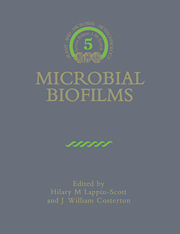Book contents
- Frontmatter
- Contents
- List of Contributors
- Series Preface
- Introduction to Microbial Biofilms
- Part I Structure, Physiology and Ecology of Biofilms
- Part II Biofilms and Inert Surfaces
- Part III Biofilms on the Surfaces of Living Cells
- 12 The Rhizosphere as a Biofilm
- 13 Biofilms of the Ruminant Digestive Tract
- 14 The Immune Response to Bacterial Biofilms
- 15 Bacterial Biofilms in the Biliary System
- 16 Biofilm Associated Urinary Tract Infections
- 17 The Role of the Urogenital Flora in Probiotics
- 18 Dental Plaque
- Index
13 - Biofilms of the Ruminant Digestive Tract
Published online by Cambridge University Press: 24 November 2009
- Frontmatter
- Contents
- List of Contributors
- Series Preface
- Introduction to Microbial Biofilms
- Part I Structure, Physiology and Ecology of Biofilms
- Part II Biofilms and Inert Surfaces
- Part III Biofilms on the Surfaces of Living Cells
- 12 The Rhizosphere as a Biofilm
- 13 Biofilms of the Ruminant Digestive Tract
- 14 The Immune Response to Bacterial Biofilms
- 15 Bacterial Biofilms in the Biliary System
- 16 Biofilm Associated Urinary Tract Infections
- 17 The Role of the Urogenital Flora in Probiotics
- 18 Dental Plaque
- Index
Summary
Introduction
Direct observations of microbial growth in a large number of natural ecosystems have shown that the predominant populations are attached to surfaces where they grow in glycocalyx enclosed microcolonies that develop into adherent biofilms (Costerton et al. 1987; Cheng et al. 1991; Lappin-Scott et al. 1992). In various digestive tracts, this adhesion takes the form of very specific associations with insoluble nutrients (Cheng et al. 1977; Akin 1979; Cheng et al. 1991) to form particle associated microbial populations, and with tissue surfaces to form tissue associated populations (Cheng & Costerton 1980; Cheng et al. 1981a, b). A variation of this latter mode of growth is the association of a major microbial population with the mucous blanket of secretory intestinal tissue (Rozee et al. 1982). Bacteria of the ruminant digestive tract can be divided into three distinct subpopulations, (i) those associated with the digesta, (ii) those associated with gastrointestinal tissue and (iii) those associated with gastrointestinal fluid (Cheng & Costerton 1980; Cheng et al. 1981a; Czerkawski & Cheng 1988).
General principles of microbial ecology dictate that any organism will establish itself in a favourable nutrient niche and proliferate within a physiologically integrated community. Our observations of the growth of bacteria associated with feed particles indicate that each species adheres to its own particular insoluble substrate (e.g. cellulose, protein, starch) and produces enzymes to degrade insoluble substrates to soluble nutrients (Cheng et al. 1984; McAllister et al. 1990b).
- Type
- Chapter
- Information
- Microbial Biofilms , pp. 221 - 232Publisher: Cambridge University PressPrint publication year: 1995
- 8
- Cited by

